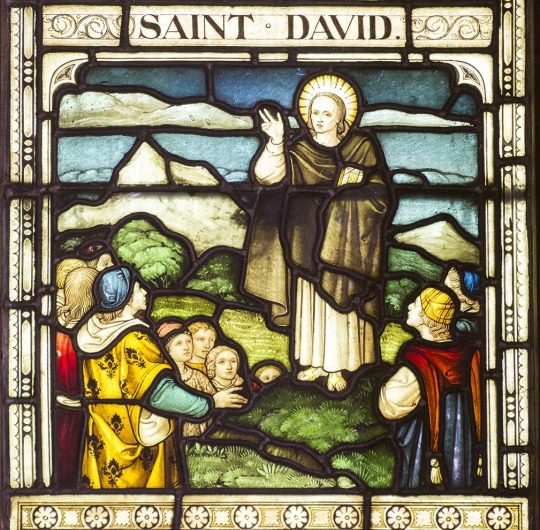#Whuppity Stourie
Explore tagged Tumblr posts
Text
1st March
St David’s Day

Source: Welsh Saints from Welsh Churches by Martin Crampin/ Mae Ffydd Yn Cyrif website
Today is St David’s Day. The patron saint of Wales, David died on 1st March 589. He was founder and Abbot of Glyn Rhosyn monastery in Dyfed (now the town of St Davids). The construction of David’s monastic seat was not trouble free and his builders were assailed by a local pagan known as Boia who wanted to prevent the work going ahead. David, who was a great preacher and proselytiser, spoke to Boia and converted him to Christianity on the spot. Although Boia’s wife then sent her handmaidens naked to distract David’s labourers, such was the saint’s oratorical power, not a man wavered and the monastery was completed.
David’s fame spread when he began miraculously to make wells appear, but his patron sainthood really owes itself to his spirit appearing to King Cadwallon of Gwynedd on the eve of the Battle of Hatfield Moors in South Yorkshire against King Edwin of Northumbria. He advised the Britons to place leeks in their helmets, the better to distinguish themselves from their English foes in the heat of battle. This they did and triumphed on the field. Although this visitation confirmed David as the patron saint of Wales and the leek as its national vegetable, Cadwallon himself did not consider himself Welsh (an English term for “foreigner”): as far as he was concerned, he was leading a Celtic attempt to evict the invading Angles from northern Britain, and he nearly succeeded. Nonetheless, from the British victory at Hatfield, it became traditional for the Welsh to wear leeks on St David’s Day, although these days a discreet daffodil lapel pin is more likely to be seen.
In Lanark, an obscure, but possibly quite ancient, mock battle takes place at the local church, named Whuppity Stourie. Two sets of lads, representing New and Old Lanark, run three times sunwise round the church before engaging in combat, traditionally using their caps as weapons, at Wellgate Head. The fight now takes place with paper maces, after the two gangs had dangerously substituted their caps for stones. With its running around a sacred building followed by a pummelling contest, Whuppity Stourie may have a winter vs spring ritual origin, with the forces of winter darkness being beaten back, but ultimately it may merely have been a way of controlling youthful gang violence in the town.
#st david#wales#leek#glyn rhosyn#st davids Dyfed#battle of Hatfield Moors#king Cadwallon#king Edwin of Northumbria#lanark#Whuppity Stourie
5 notes
·
View notes